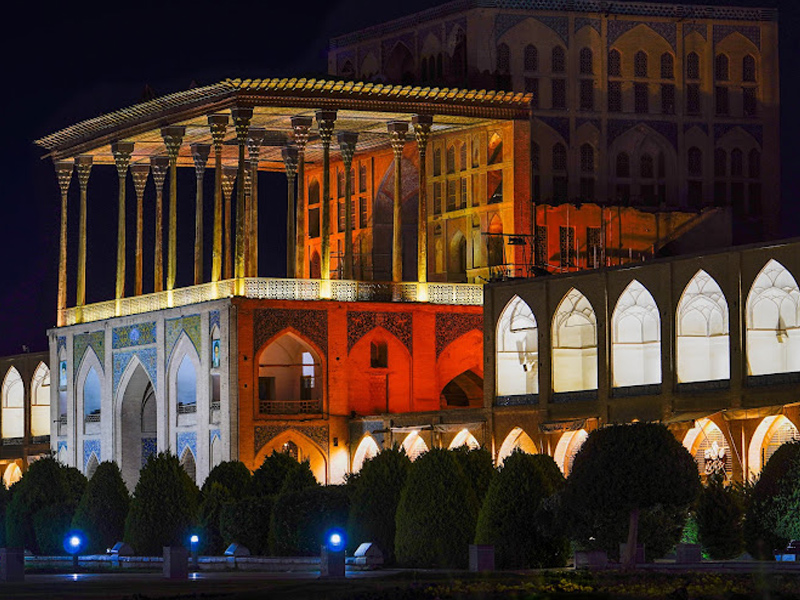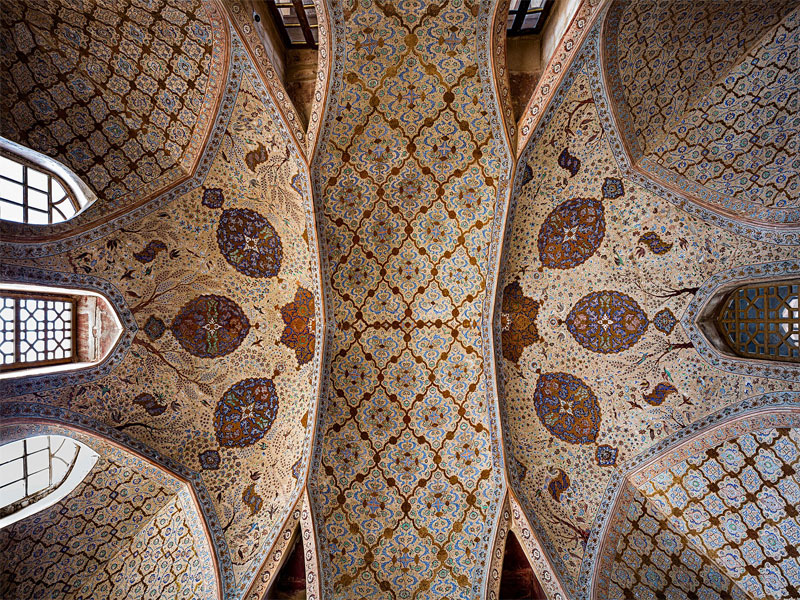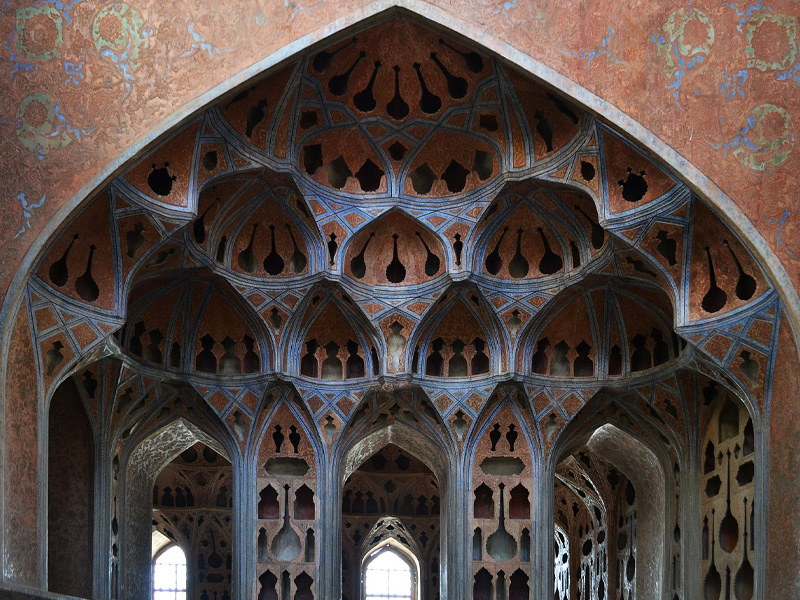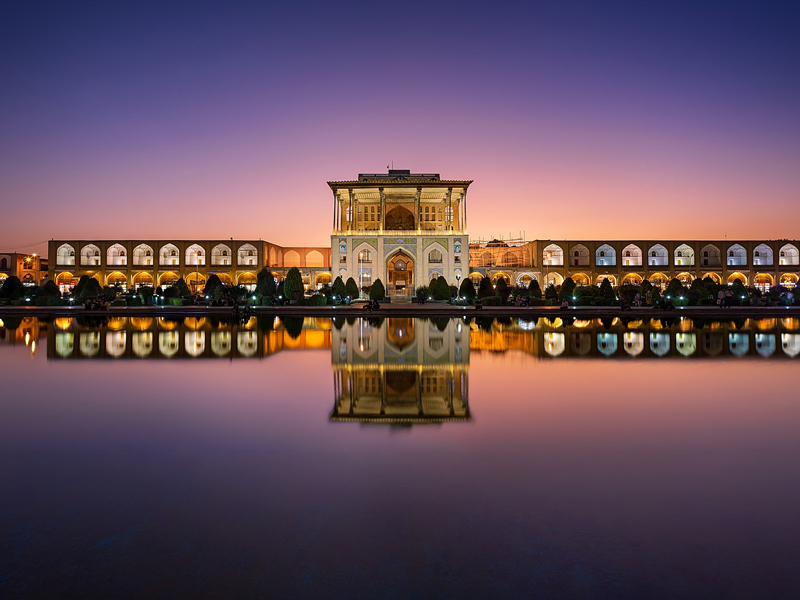Ali Qapu Mansion is a masterpiece of architectural art with a unique identity. This mansion, with its beautiful design and unparalleled geometric lines, is not only a tall and attractive building but also a symbol of the enduring Safavid history. The distinctive architecture and different sections of Ali Qapu turn it into an intriguing work of art, providing visitors with an exceptional experience of blending art and architecture. For this reason, in this article from Eligasht, we intend to introduce you to the magnificent Ali Qapu Palace and its beautiful architecture, acquainting you with this unique architectural masterpiece in Isfahan.
Book Iran Air flights from London to Tehran and Tehran to London with Eligasht UK:
History of Ali Qapu Mansion
Ali Qapu Mansion is one of the historical sites in the city of Isfahan, rooted in the Safavid era. The initial construction of the grand and beautiful Ali Qapu Palace dates back to the Timurid period. Later, by the order of Shah Abbas I in 1594, Ali Qapu Mansion was built, and since then, it has been recognized as one of the cultural and historical symbols of Isfahan. Initially serving as the headquarters and government house of the Shah Abbas court, over time, it transformed into a royal palace with exceptional architectural features. Ali Qapu Mansion, with its intelligent design, orderly plan, and unique artistic works, encompasses a historic background and is known as a cultural gem in the heart of Isfahan from an architectural perspective.
Reason for Naming Ali Qapu Mansion
The reason behind naming the Ali Qapu Mansion in Isfahan derives from a sweet combination of history and the Turkish language. Initially, because this building was constructed by the Turkish-speaking government, the word “Alaqaapu” was used to refer to this palace, which means “colorful door” in Turkish, with “Ala” meaning colorful and “Qapu” or “Qapi” meaning door. Isfahan has been known as one of the cultural and artistic centers of Iran since the Safavid era, and Ali Qapu represents the ancient history of this historical city.

The architecture of Ali Qapu Mansion
The architecture of Ali Qapu in Isfahan, a masterpiece of Iranian architecture, captivates the attention of every visitor with its unique characteristics. This mansion, standing at a height of 38 meters, has been intelligently designed by Iranian architects, incorporating Islamic and Safavid art principles. The architecture of Ali Qapu employs precise structures and beautiful lines adorned with paintings and mosaics, representing balance and harmony in Islamic architecture. The rooms, alcoves, columns, entrance gate, hall, and other sections form the essential elements of this mansion, decorated with painting techniques, tilework, and interior architecture, showcasing an evolved work of art that reflects the taste of architects of that era.
Related post
The most delicious local dishes of Isfahan for tourists
An Eternal Fire in Iran that Has Burned for 1500 Years!
Different Sections of Ali Qapu Mansion
Ali Qapu Mansion in Isfahan, with its beautiful Iranian structure, is composed of various sections, each possessing its own artistic and historical value. Some of the different sections of Ali Qapu Mansion include:

Entrance to the Palace
Entering Ali Qapu, with stone platforms on both sides, is like entering a story of history and art, filled with wonder and astonishment. The tall and magnificent main gate, with mesmerizing tilework and paintings, guides visitors into a world of beauty and marvel. This gate was formerly known as “Dowlatkhaneh Gate,” which served as a connection point between Naghsh-e Jahan Square and other grand buildings such as Dowlatkhaneh, Jabeh Khaneh, Timurid Hall, Chehel Sotoun Palace, and many other mansions. By passing through this gate, visitors enter the heart of this architectural masterpiece and experience a different sense of Iran’s history and culture by admiring the beautiful details, such as the intricate tilework on columns and walls.
Music Hall
The music hall, also known as the sound chamber, is one of the important and captivating parts of Ali Qapu Palace, located on the sixth and top floors of the palace. This architectural masterpiece consists of two large rooms and a small room. It creates a unique atmosphere with its beautiful Iranian architecture, three-dimensional stucco work, and engravings of musical instruments and goblets. The palace used to have wooden and golden doors, which were designed for it during the Safavid period and are now preserved in the Louvre Museum in France.

Interior Decorations
The interior decorations of Ali Qapu Palace are a masterpiece of art and architectural taste from the Safavid era. From the first floor to the top floor, you can witness the unmatched Iranian and traditional architecture and beautiful decorations. The walls, ceilings, and doors are adorned with paintings by artists of that period and exquisite plasterwork, which still reflect the artistic and cultural significance of Iran. These interior decorations have transformed every corner of Ali Qapu into a living work of art that transcends time.
Furthermore, the third floor of the palace is decorated with beautiful mirror work, attractive columns, and painted ivans, which used to be the place for witnessing competitions and ceremonies in Naghsh-e Jahan Square.
Cultural Significance
Hosting Royal Ceremonies and Festivities
Ali Qapu Mansion played a significant role in hosting important royal ceremonies, including coronations, receptions, and celebrations. The mansion’s grandeur and architectural splendor created a fitting backdrop for these momentous events, allowing the Shah to display his power and prestige to both local and foreign dignitaries.
Symbol of Safavid Legacy
Ali Qapu Mansion stands as a testament to the artistic and cultural achievements of the Safavid dynasty. It represents the golden age of Persian architecture and serves as a reminder of the grandeur and sophistication of the Safavid rulers. The mansion has become an iconic symbol of Isfahan and a source of pride for Iranians.

Tourist Attractions around Ali Qapu Palace
There are valuable and significant attractions around Ali Qapu Palace and on all four sides of Naghsh-e Jahan Square that tourists can visit after exploring Ali Qapu. Some of the most important attractions include Naghsh-e Jahan Square, Dowlatkhaneh, Rakib Khaneh, Hasht Behesht Palace, and Chehel Sotoun Palace. Additionally, Shah Mosque, Atiq Mosque, Karvansaray-e Ali Qapu Bridge, which dates back to the Safavid era, and Qeisarieh Gate on the northern side, as well as Sheikh Lotfollah Mosque on the eastern side of the square, have turned this area into a significant tourist destination.
Where is Ali Qapu Palace located?
Ali Qapu Palace is located in the heart of the historical city of Isfahan and is open to visitors from 9 am to 6 pm. This architectural masterpiece is situated on the western side of Naghsh-e Jahan Square, between Hafez Street to the east and Sepah Street to the west. Due to the historical and artistic significance of Isfahan, Ali Qapu Palace was constructed in a neighborhood filled with historical and religious sites. To reach Ali Qapu, you first need to go to Ostandari Street and then make your way to Sepah or Hafez Street, ultimately reaching Ali Qapu Palace on the western side of Naghsh-e Jahan Square.
If you are traveling by private car to visit this beautiful palace, you can park your car in the public parking lot on Sepah Street and then reach the palace with a short walk.
Final Words
Ali Qapu Palace in Isfahan stands as a symbol of art, history, and beauty in the heart of this historical city. With its intelligent design, exquisite artistic decorations, and favorable geographical location, this architectural masterpiece attracts many visitors. From its stunning exterior facade to its extraordinary interior decorations and close proximity to surrounding attractions, it creates an artistic and cultural marvel that still shines eternally in the heart of Isfahan. This palace plays a prominent role in preserving and enhancing the historical identity of Isfahan and invites visitors every day to a world of beauty and a glimpse into the past, serving as a treasure trove of art, history, and culture.

FAQ
1- What are the architectural features that make Ali Qapu Mansion unique?
Ali Qapu Mansion is renowned for its distinctive architectural features. One notable aspect is its magnificent portal entrance adorned with intricate tilework and paintings. The mansion’s six-story structure showcases intricate stucco work, beautifully carved wooden columns, and exquisite ceiling designs. Its music hall, with its sound chamber and stunning acoustics, is a remarkable architectural gem that highlights the artistic ingenuity of the time.
2- What can visitors expect to see inside Ali Qapu?
Inside Ali Qapu Palace, visitors can explore various floors and rooms, each with its own charm. The upper floors offer breathtaking views of Naghsh-e Jahan Square and the surrounding landmarks. The music hall on the top floor features elaborate plasterwork, frescoes, and depictions of musical instruments. The mansion’s interior is adorned with intricate tilework, beautiful paintings, and decorative motifs, showcasing the artistic mastery of the Safavid period.
3- Are there any notable attractions near Ali Qapu Mansion?
Yes, there are several notable attractions near Ali Qapu Mansion. Naghsh-e Jahan Square, one of the largest squares in the world and a UNESCO World Heritage site is just steps away. Visitors can explore other magnificent structures like Sheikh Lotfollah Mosque, Imam Mosque, and the mesmerizing Qeisarieh Gate. Additionally, Chehel Sotoun Palace, Hasht Behesht Palace, and the vibrant bazaar of Isfahan are within walking distance, offering visitors a comprehensive experience of the city’s rich history and cultural heritage.

